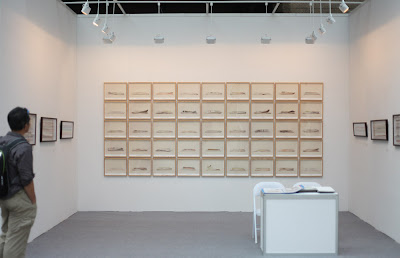英文:這些繪畫或許反映著越南詩意的自然美、著名的當代世界的建築奇觀,像是艾菲爾鐵塔、雪梨歌劇院、或自由女神,甚至是傑出的世界領袖的肖像,像是美國總統或是俄國總理。一張畫從5-20美元不等。– 我的越南護照觀光網站
越文:胡志明市有著不多的當代藝廊,因為大部份的藝廊都很難賣作品,也因為很少當地的藏家,大部份當代藝術的藏家都是外國人。 – Lã Huy
英文:從1960到1975,西貢的越南小孩比較大隻,她說,因為美國人。– 國家地理雜誌
越文:當我看到這張照片,我好奇觀光客覺得他們實際上所看到的東西如何,比起那些從明信片或他們從自己國家購買的書上看到的。事實是,大部份上面寫的資訊及影像都不是真的。– Lưu Danh Quyền
英文:地下的隧道都被拓寬了,所以就算胖的觀光客也可以通過。– 國家地理雜誌
越文:不管你喜不喜歡,戰爭在美國還是一個熱門的話提,但我想要人們以另一個角度來看,停止製造仇恨,或是讓戰爭變成我們的符號。這個經驗應該拿來教導大家如何更恰當的跟人相處。戰爭不是一個好東西。– Lương Lưu
Biên
英文:在一個充滿貧窮、飢餓、疾病、文盲的世界裡沒有和平,我們有機會,我們有這個義務,來創造一個先父所談論與尋找的新世界。– 第三世界發展議題
越文:當我剛看到這張照片時,我覺得很酷。我的意思是說,這個游泳池看起來很好很豪華。但我怕水,而游泳池就是一個玩水跟泡腳的地方。游泳對我而言很遙遠因為我怕水。但如果我很有錢,我想我會在我的房子裡蓋一個游泳池,所以我的小孩和老公就會很愛水,比我玩得更開心。– Linh Psyko
英文:到處都是異國情調與日常生活的景象。– Lonely Planet
越文:人們喜歡將越南、或任何發展中國家連結到骯髒。然而,我相信任何國家都有這樣的角落。– Pé Heo
英文:你可以吃蛇、烏龜、鹿茸以及其他異國料理到飽,在Try Ky餐廳。– Lonely Planet
越文:越南,特別是年輕人,在濫用西方文化的進入,有時候他們失去了自己。因為世界是平的。那些沒有特色的文化,會被更大的文化所取代,越南是個很好的範例。– Loan Tran
英文:街頭上的小孩環繞著觀光客兜售T、明信片和打火機,沒有手腳的乞丐用推車拖著自己,扒手們東張西望的在 Dong Khoi尋找著沒有防備好的皮夾。– 越南觀光手冊
越文:孩童的笑容從來不會消失。在發展後,我們很少看到孩子們在公園裡玩。取代的是,我們看到他們在百貨公司。然而,這不代表什麼,因為他們的笑容還是永遠自然跟被珍惜的。– Pé Heo
英文:我們用亞洲的眼睛看,亞洲的腦思考,西班牙的心來服務。– Melia旅館與貿易中心
越文:想像有一天,越南會被發展成像是香港、澳門或新加坡一樣的城市,變成另一顆星星。– Hoang Nga
英文:最震驚的事實是,在這些政治正確的繪畫裡,所有的越南戰爭英雄看起來都像歐洲人,而不像亞洲人。– Lonely Planet
越文:胡志明市的外國人社區常常有著他們自己的聚會,第二區是大部份外國人住的地方,很安全,路也很乾淨,但以前,這個地方是沼澤,所以當漲潮的時候,道路還是會淹水。– Lã Huy
越文:對我而言,這張照片是胡志明市。人們從維基百科來知道胡志明市,但對我而言,最好的是家庭的價值。我來告訴你為什麼(從左到右)。我的二哥曾經是流氓、毒販,他做了一些讓我恨他的事情,但這些都過去了,現在,他有了老婆跟小孩,我知道他關心也愛我和我的家庭。接著是我們的哥哥,他加入軍隊,而且一直是兄弟姊妹之間最負責任的,我覺得他有點傻,但是他有了老婆跟小孩,而且他永遠是家中的男人。接著是他的老婆,我不太知道她的事情。接著是我們最大的哥哥,我們永遠是兄弟,但是我們從來沒有什麼話聊,他是個被誤導的一代,大部份他的朋友都因為毒品而死,而他還活著。接著是我的繼父,他是中國人,永遠很負責人又幽默。我總是尊重他。接著是我的姐姐,她很吵但是總是聽我說話也瞭解我。我覺得她是家裡的美人,是瞭解整個家庭的人。我的媽媽(後)是我信任的人。我有次問她,她在1975年4月30日那天在做什麼,她回答,我正要去學校,然後在聽了連續兩天的槍聲後才回家。接著是我的外婆,她總是看著我們然後微笑。接著是我大哥的兩個女兒,一個很新潮另一個很好笑。我相信她們會是我們的未來。– Phan Minh Tuấn (Liar Ben)

























































